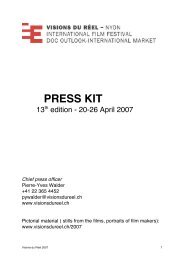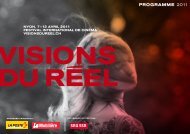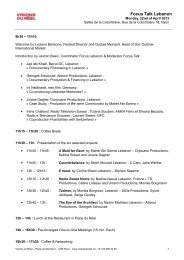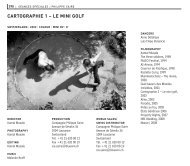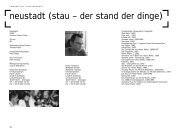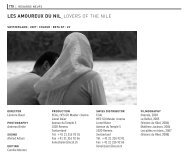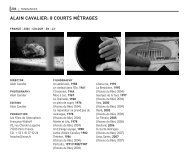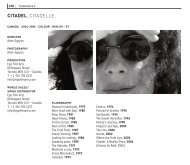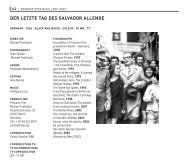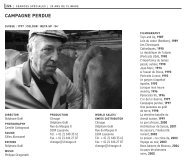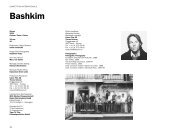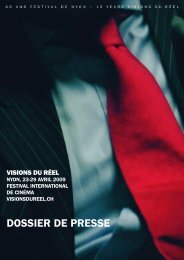Katalog 2013.pdf - Visions du Réel
Katalog 2013.pdf - Visions du Réel
Katalog 2013.pdf - Visions du Réel
Create successful ePaper yourself
Turn your PDF publications into a flip-book with our unique Google optimized e-Paper software.
130 état d’esprit<br />
Juha Suonpää<br />
Hukkamies<br />
Finland | 2013 | 75’ | XD CAM, Stereo DV, Stereo | Finnish<br />
Wolfman<br />
World Premiere<br />
compétition regard neuf<br />
Cinematography<br />
Heikki Färm<br />
Sound<br />
Heikki Innanen<br />
Editing<br />
Tuuli Kuittinen<br />
Pro<strong>du</strong>ction<br />
Timo Vierimaa<br />
(Oktober Oy),<br />
Joonas Berghäll<br />
(Oktober Oy)<br />
Filmography<br />
2013 Hukkamies<br />
Contact<br />
Oktober Oy<br />
Timo Vierimaa<br />
+358 407079619<br />
tinke@oktober.fi<br />
Seppo Ronkainen a étudié le langage et<br />
les habitudes des loups pendant treize<br />
ans. Il fut embauché pour documenter la<br />
vie de ces animaux et récolter des données.<br />
En 1988, le réalisateur lui donna<br />
une caméra pour qu’il filme son quotidien<br />
avec les loups. Il les appelle par<br />
leur nom, connaît leur lien de parenté et<br />
parle d’eux comme de sa famille. C’est<br />
autour des images qu’il a récoltées pendant<br />
ces treize années que le film est<br />
construit. Pourtant, malgré des prisesde-vue<br />
extraordinaires, le réalisateur<br />
a choisi d’adopter une voix douce, un<br />
rythme anti-spectaculaire, une approche<br />
respectueuse et intimiste. « Hukkamies<br />
parle de l’éthique environnementale […]<br />
à travers la complexité de la relation<br />
entre une espèce en danger et l’homme.<br />
Comme beaucoup de carnivores, le loup<br />
est souvent controversé et souffre de<br />
nombreux clichés. En regardant de plus<br />
près et sans préjugés le lien entre le loup<br />
et l’homme, on peut briser le stéréotype<br />
<strong>du</strong> ‘grand méchant loup’ et considérer<br />
que l’homme fait simplement partie de la<br />
nature » (JS). L’immersion dans cet environnement<br />
décuple nos sens : on peut<br />
presque sentir la neige tomber sur nous,<br />
l’air pur dans nos poumons ainsi qu’une<br />
connexion et une empathie troublantes<br />
envers une « famille » dont nous faisons,<br />
au bout <strong>du</strong> compte, aussi partie.<br />
Seppo Ronkainen hat 13 Jahre lang die<br />
Sprache und das Leben der Wölfe studiert.<br />
Er wurde angeheuert, das Leben<br />
der Wölfe zu beobachten und Daten zu<br />
sammeln. Der Regisseur gibt ihm 1998<br />
eine Kamera und Seppo beginnt, sein<br />
Leben mit den Wölfen zu filmen. Er nennt<br />
sie beim Namen, kennt ihre Sozialbeziehungen<br />
und sieht sie als seine Familie.<br />
Der Film baut auf den von Seppo in<br />
diesen 13 Jahren gedrehten Bildern auf,<br />
doch trotz des einzigartigen Materials<br />
wählt der Regisseur einen leisen Tonfall,<br />
einen antispektakulären Rhythmus<br />
und eine respektvolle, intime Sichtweise.<br />
«Hukkamies befasst sich anhand der<br />
komplexen Beziehungen […] zwischen<br />
einer bedrohten Art und dem Mensch<br />
mit Umweltethik. Wie viele andere<br />
Fleischfresser umgibt den Wolf eine von<br />
Klischees besetzte Aura. Durch die offenere<br />
Betrachtung der Bande zwischen<br />
Wolf und Mensch können wir die stereotypische<br />
Idee des ‘grossen bösen Wolfs’<br />
<strong>du</strong>rchbrechen und den Menschen ganz<br />
einfach als einen Teil der Natur sehen»<br />
(JS). Das eindringliche Erleben dieser<br />
Umwelt verstärkt die Sinneseindrücke:<br />
Wir können den Schnee um uns herum<br />
fast fallen hören, die dünne Luft in unseren<br />
Lungen spüren und empfinden eine<br />
verwirrende Empathie und Verbin<strong>du</strong>ng<br />
mit einer «Familie», zu der wir letztendlich<br />
gehören.<br />
Seppo Ronkainen studied the language<br />
and the habits of wolves for 13 years.<br />
He was hired to monitor the life of the<br />
wolves and to collect data. The director<br />
gave him a camera in 1998 and Seppo<br />
starts filming his everyday life shared<br />
with wolves. He calls them by name,<br />
knows how they are related to each<br />
other and talks about them as his family.<br />
The film is built around the images<br />
Seppo shot <strong>du</strong>ring those 13 years.<br />
Despite the extraordinary material, the<br />
director chooses a soft-spoken tone, an<br />
antispectacular rhythm, a respectful, intimate<br />
approach. “Hukkamies deals with<br />
environmental ethics […] through the<br />
complexity of the relationship between<br />
an endangered species and mankind.<br />
Like many other carnivores, the wolf is<br />
surrounded by a controversial aura and<br />
many clichés. By taking a closer and<br />
a more open-minded look at the bond<br />
between wolf and man, we can break<br />
the stereotypical idea of the ‘big bad<br />
wolf’ and just consider man as part of<br />
nature” (JS). The immersive experience<br />
of this environment amplifies our senses:<br />
we can almost feel the snow falling on<br />
us, the thin air in our lungs and a troubling<br />
empathy and connection with a<br />
“family”. of which we are, after all, a part.<br />
Paolo Moretti



